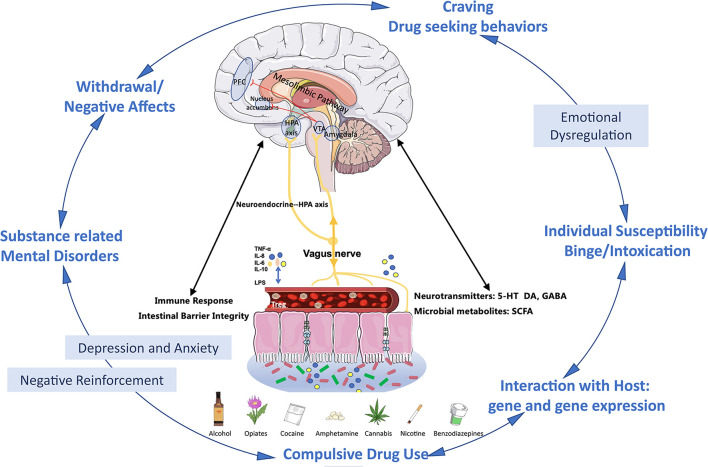FIGURE 1.
Microbiome–gut–brain in substance use disorders and substance-related mental disorders. First, via the microbiome–gut–brain axis, substance exposure-induced dysbiosis leads to the damage of the gut epithelial barrier. In turn, it further causes the increased permeability (“leaky gut”) of bacterial products such as LPS lipopolysaccharide (LPS), immune cytokines (TNF-α, IL-6, IL-8, IL-10, etc.), hormones, neurotransmitters, and microbial metabolites produced by the gut microbiome. These products can be released to the systemic circulation such as blood stream and then transported to the brain, and these gut derived components also target the HPA axis and vagus nerve. These all together further impact on brain barrier integrity and immunoactivities in brains and alter the reward system (Carbia et al., 2021; Garcia-Cabrerizo et al., 2021). Second, the gut microbiome plays an important role in the cycle of development and maintenance of addiction. At the binge/intoxication stage, substance use is mainly initiated by individual susceptibility of the drug, which might be determined by the interaction between the microbiome and the host genetic background. In this stage, the same emotional problems might also precede the use of the drug. Repeated binge induces the progressively microbiome imbalances and contributes to early emotional dysregulation, and further motivates the craving and drug seeking behaviors. At the withdrawal/negative effect stage, exaggerated emotional disturbances and dysbiosis combine with the negative effects related to withdrawal driven negative reinforcement and finally accelerate the transition to compulsive alcohol use (Wise and Koob, 2014; Carbia et al., 2021; Garcia-Cabrerizo et al., 2021). Additionally, the substance-related mental disorders, especially depression and anxiety, could further exacerbate dysbiosis (Reyes et al., 2020; Carbia et al., 2021). Abbreviations: PFC, prefrontal cortex; VTA, ventral tegmental area; NAc, nucleus accumbens; AMYG, amygdala; NTS, nucleus tractus solitarii; IL, interleukin; TNF, tumor necrosis factor; LPS, lipopolysaccharide; SCFA, short-chain fatty acids; 5-HT, 5-hydroxytryptamine; DA, dopamine; GABA, γ-aminobutyric acid; HPA, hypothalamic–pituitary–adrenal.

